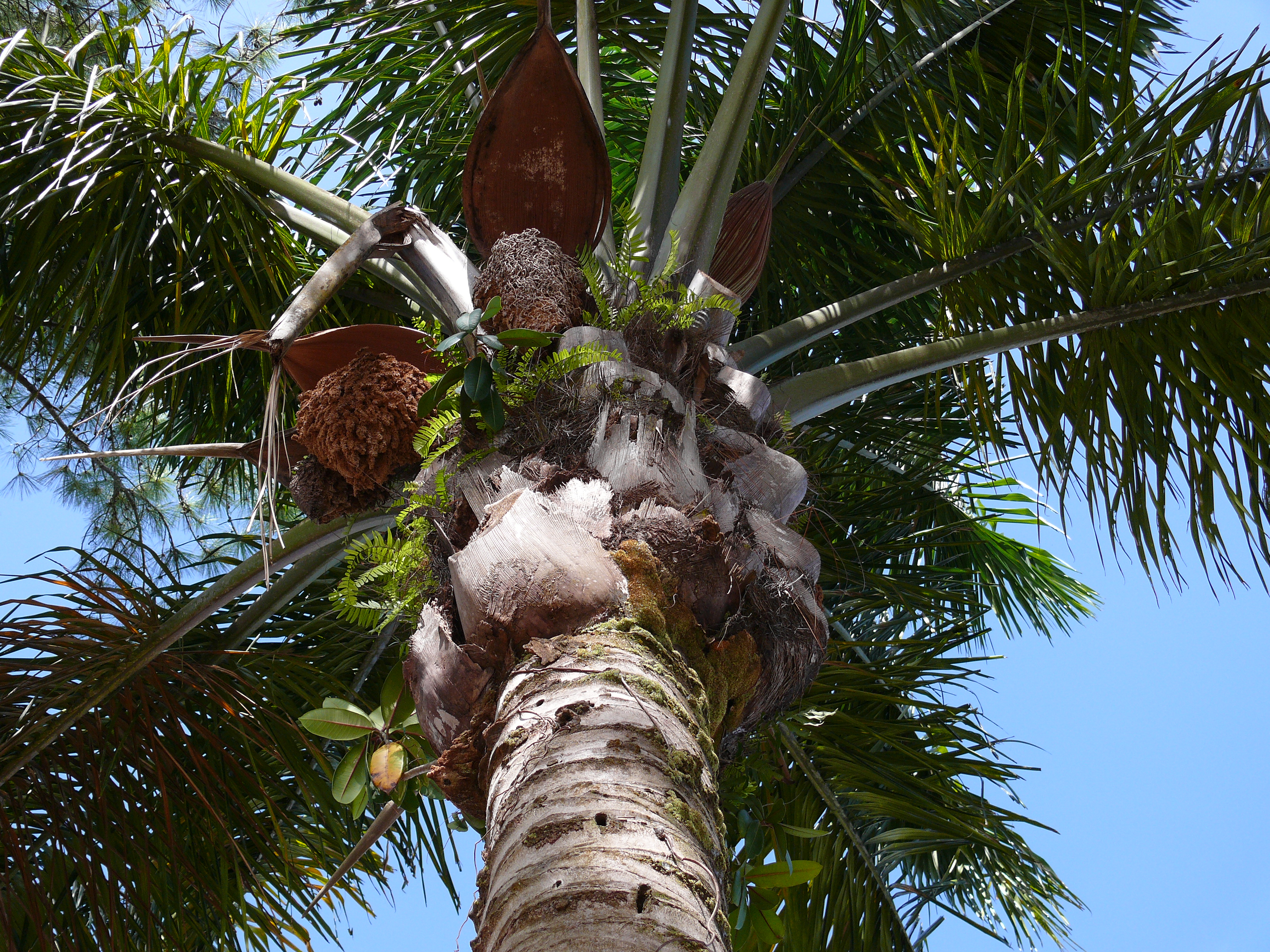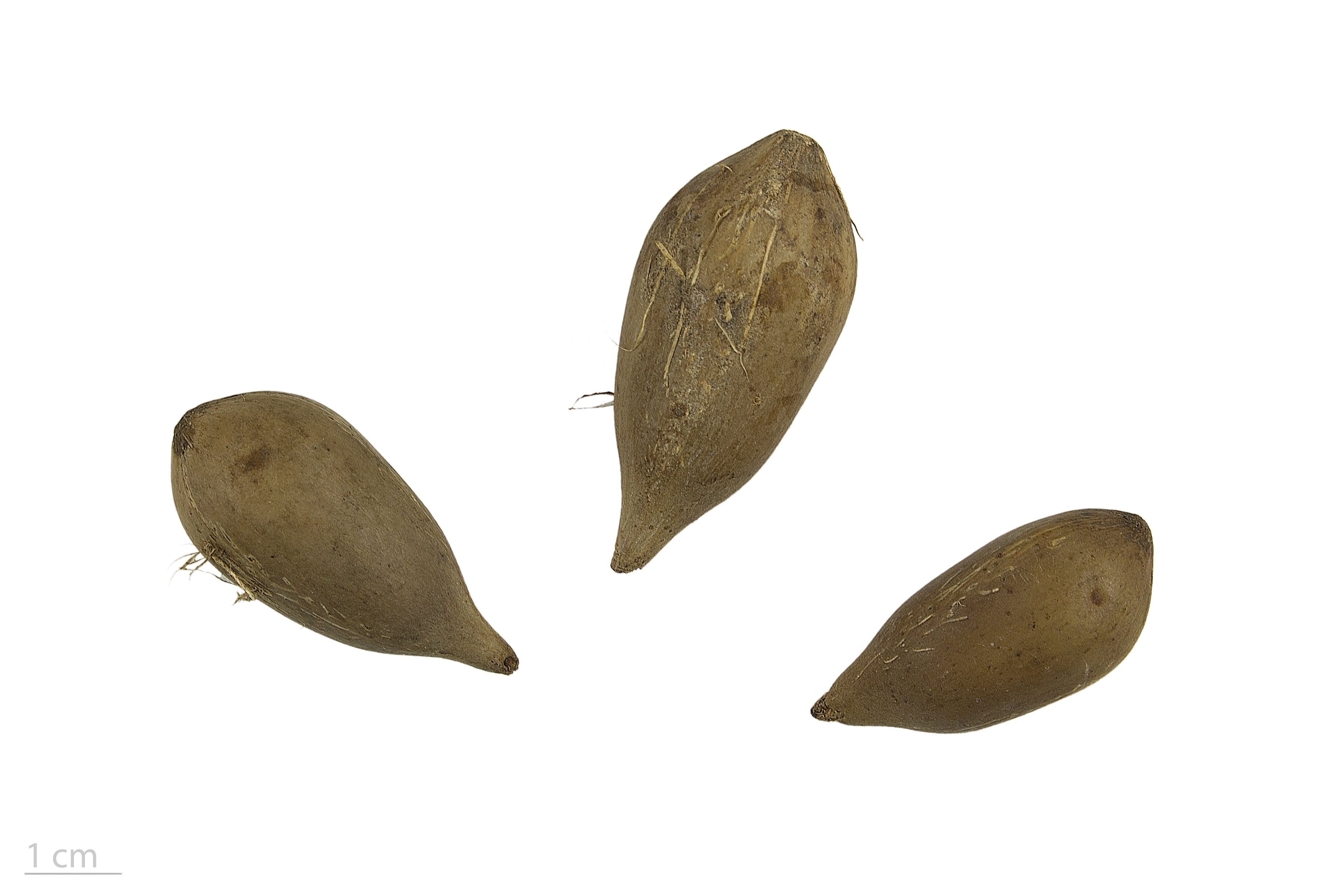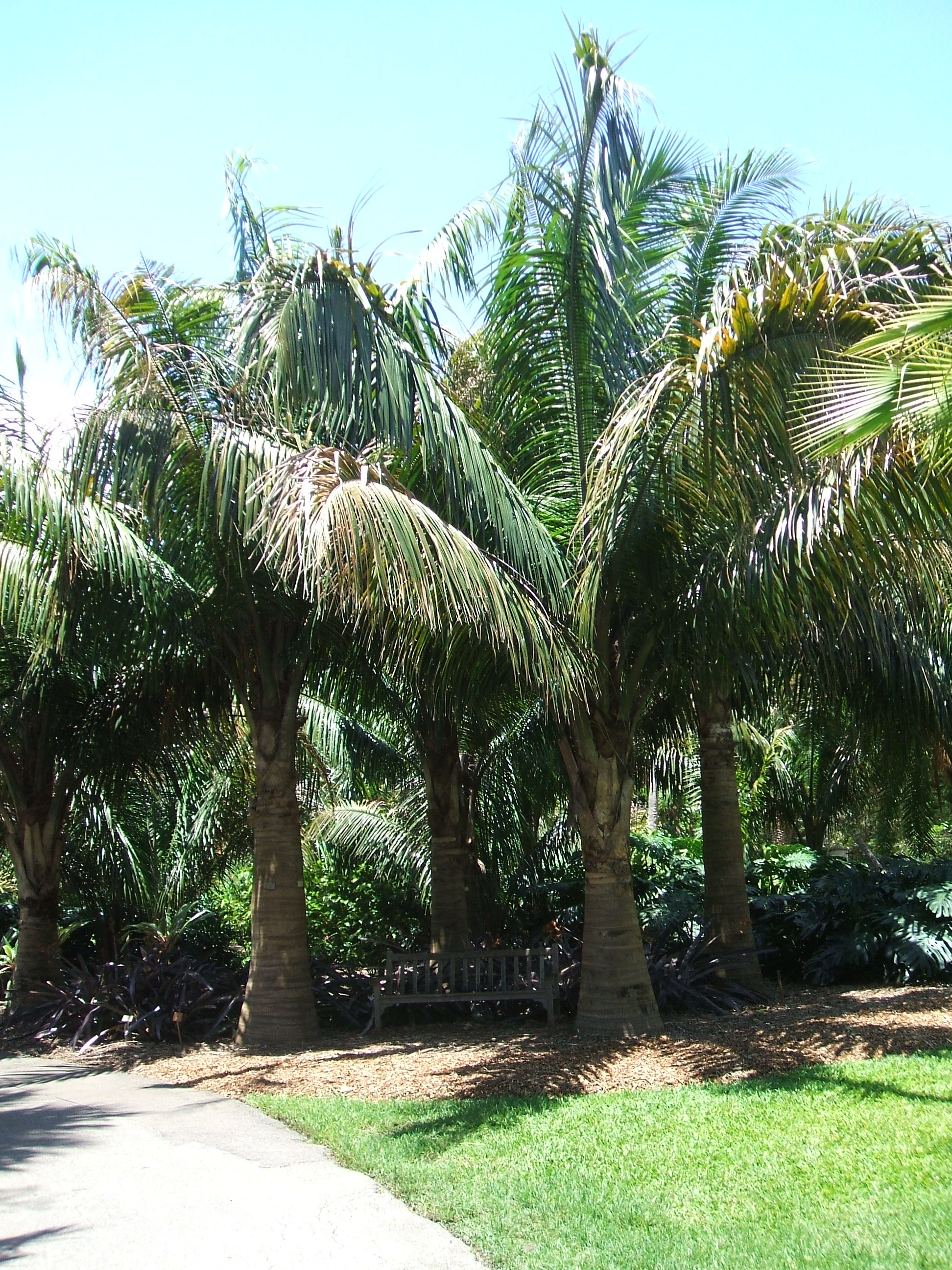|
Attalea Crassispatha
''Attalea crassispatha'' is a palm which is endemic to southwest Haiti. The most geographically isolated member of the genus, it is considered a critically endangered species and has been called one of the rarest palms in the Americas. Description ''Attalea crassispatha'' has a single stem which grows up to tall. The stem is grey, up to in diameter, and can be columnar, or slightly swollen at the base of the middle of the stem. Individuals bear 15 to 19 pinnately compound leaves—leaves in which rows of leaflets emerge on either side of the axis of the leaf in a feather-like or fern-like pattern—with 127 to 165 pairs of leaflets. Leaves consist of a leaf sheath which wraps around the trunk, a rachis, from which the leaflets emerge, and a petiole, which connects the leaf sheath with the rachis. The leaf sheath is open (it does not wrap completely around the stem); when the leaf is shed, the leaf sheath detached cleanly from the stem. The sheath and petiole combined are ... [...More Info...] [...Related Items...] OR: [Wikipedia] [Google] [Baidu] |
Fairchild Tropical Botanic Garden
Fairchild Tropical Botanic Garden is an botanic garden with extensive collections of rare tropical plants including palms, cycads, flowering trees, and vines. It is located in the city of Coral Gables, Miami-Dade County, just south of Miami, surrounded at the north and west by Matheson Hammock Park. Fairchild opened to the public in 1938. Fairchild is a museum, laboratory, learning center, and conservation research facility whose main role is preserving biodiversity. It has 45,000 members and more than 1,200 volunteers. In 2012, Fairchild became the home of the American Orchid Society. History The garden was established in 1936 by Robert H. Montgomery (1872–1953), an accountant, attorney, and businessman with a passion for plant-collecting. Montgomery pursued the creation of a botanical garden in Miami. He purchased the 83-acre site along Biscayne Bay and later deeded it in large part to Miami-Dade County. Montgomery named the garden after his friend, renowned plant expl ... [...More Info...] [...Related Items...] OR: [Wikipedia] [Google] [Baidu] |
Peduncle (botany)
In botany, a peduncle is a stalk supporting an inflorescence or a solitary flower, or, after fecundation, an infructescence or a solitary fruit. The peduncle sometimes has bracts (a type of cataphylls) at nodes. The main axis of an inflorescence above the peduncle is the rachis. There are no flowers on the peduncle but there are flowers on the rachis. When a peduncle arises from the ground level, either from a compressed aerial stem or from a subterranean stem (rhizome, tuber, bulb, corm), with few or no bracts except the part near the rachis or receptacle, it is referred to as a scape. The acorns of the pedunculate oak are borne on a long peduncle, hence the name of the tree. See also *Pedicel (botany) *Scape (botany) In botany, a scape is a peduncle arising from a subterranean or very compressed stem, with the lower internodes very long and hence few or no bracts except the part near the rachis or receptacle. Typically it takes the form of a long, leafles ... Re ... [...More Info...] [...Related Items...] OR: [Wikipedia] [Google] [Baidu] |
Scheelea
''Attalea'' is a large genus of palms native to Mexico, the Caribbean, Central and South America. This pinnately leaved, non-spiny genus includes both small palms lacking an aboveground stem and large trees. The genus has a complicated taxonomic history, and has often been split into four or five genera based on differences in the male flowers. Since the genera can only be distinguished on the basis of their male flowers, the existence of intermediate flower types and the existence of hybrids between different genera has been used as an argument for keeping them all in the same genus. This has been supported by recent molecular phylogenies. Between 29 and 67 species are recognised in the genus, with estimates of as many as 100. Incomplete herbarium collections make it difficult to determine whether certain groups represent single species, or groups of similar species. ''Attalea'' species have a long history of human use, and include economically important sources of palm oil and ... [...More Info...] [...Related Items...] OR: [Wikipedia] [Google] [Baidu] |
Alan W
Alan may refer to: People *Alan (surname), an English and Turkish surname *Alan (given name), an English given name **List of people with given name Alan ''Following are people commonly referred to solely by "Alan" or by a homonymous name.'' *Alan (Chinese singer) (born 1987), female Chinese singer of Tibetan ethnicity, active in both China and Japan *Alan (Mexican singer) (born 1973), Mexican singer and actor * Alan (wrestler) (born 1975), a.k.a. Gato Eveready, who wrestles in Asistencia Asesoría y Administración *Alan (footballer, born 1979) (Alan Osório da Costa Silva), Brazilian footballer *Alan (footballer, born 1998) (Alan Cardoso de Andrade), Brazilian footballer *Alan I, King of Brittany (died 907), "the Great" *Alan II, Duke of Brittany (c. 900–952) * Alan III, Duke of Brittany(997–1040) *Alan IV, Duke of Brittany (c. 1063–1119), a.k.a. Alan Fergant ("the Younger" in Breton language) *Alan of Tewkesbury, 12th century abbott *Alan of Lynn (c. 1348–1423), 15th ce ... [...More Info...] [...Related Items...] OR: [Wikipedia] [Google] [Baidu] |
Trinidad And Tobago
Trinidad and Tobago (, ), officially the Republic of Trinidad and Tobago, is the southernmost island country in the Caribbean. Consisting of the main islands Trinidad and Tobago, and numerous much smaller islands, it is situated south of Grenada and off the coast of northeastern Venezuela. It shares maritime boundaries with Barbados to the northeast, Grenada to the northwest and Venezuela to the south and west. Trinidad and Tobago is generally considered to be part of the West Indies. The island country's capital is Port of Spain, while its largest and most populous city is San Fernando. The island of Trinidad was inhabited for centuries by Indigenous peoples before becoming a colony in the Spanish Empire, following the arrival of Christopher Columbus, in 1498. Spanish governor José María Chacón surrendered the island to a British fleet under the command of Sir Ralph Abercromby in 1797. Trinidad and Tobago were ceded to Britain in 1802 under the Treaty of Amiens as se ... [...More Info...] [...Related Items...] OR: [Wikipedia] [Google] [Baidu] |
Attalea Osmantha
''Attalea osmantha'' (considered a synonym of the more widespread ''Attalea butyracea'' by some authors) is a large pinnately leaved palm found in Trinidad and Tobago and northern Venezuela Venezuela (; ), officially the Bolivarian Republic of Venezuela ( es, link=no, República Bolivariana de Venezuela), is a country on the northern coast of South America, consisting of a continental landmass and many islands and islets in th .... References osmantha Trees of Trinidad and Tobago Trees of Venezuela {{tree-stub ... [...More Info...] [...Related Items...] OR: [Wikipedia] [Google] [Baidu] |
Attalea Maripa
''Attalea maripa'', commonly called maripa palm is a palm native to tropical South America and Trinidad and Tobago. It grows up tall and can have leaves or fronds long. This plant has a yellow edible fruit which is oblong ovoid and cream. An edible oil can be extracted from the pulp of the fruit and from the kernel of the seed. Description ''Attalea maripa'' is a large palm that grows from tall. Stems range from in diameter, occasionally reaching up to . Trees have 10 to 22 leaves with long petioles. Fruit are large and brown or yellow, with 2 or 3 seeds which are long and in diameter They are borne in infructescences which can contain several hundred to over 2000 fruit. Taxonomy The species was first described by French botanist Jean Baptiste Christophore Fusée Aublet in 1775 in his ''Histoire des plantes de la Guiane Francoise'' as ''Palma maripa''. German botanist Carl Friedrich Philipp von Martius transferred it to the genus ''Attalea'' in 1844. Hermann Wendland ... [...More Info...] [...Related Items...] OR: [Wikipedia] [Google] [Baidu] |
Caribbean
The Caribbean (, ) ( es, El Caribe; french: la Caraïbe; ht, Karayib; nl, De Caraïben) is a region of the Americas that consists of the Caribbean Sea, its islands (some surrounded by the Caribbean Sea and some bordering both the Caribbean Sea and the North Atlantic Ocean) and the surrounding coasts. The region is southeast of the Gulf of Mexico and the North American mainland, east of Central America, and north of South America. Situated largely on the Caribbean Plate, the region has more than 700 islands, islets, reefs and cays (see the list of Caribbean islands). Island arcs delineate the eastern and northern edges of the Caribbean Sea: The Greater Antilles and the Lucayan Archipelago on the north and the Lesser Antilles and the on the south and east (which includes the Leeward Antilles). They form the West Indies with the nearby Lucayan Archipelago (the Bahamas and Turks and Caicos Islands), which are considered to be part of the Caribbean despite not bordering the Caribbe ... [...More Info...] [...Related Items...] OR: [Wikipedia] [Google] [Baidu] |
South America
South America is a continent entirely in the Western Hemisphere and mostly in the Southern Hemisphere, with a relatively small portion in the Northern Hemisphere at the northern tip of the continent. It can also be described as the southern subregion of a single continent called America. South America is bordered on the west by the Pacific Ocean and on the north and east by the Atlantic Ocean; North America and the Caribbean Sea lie to the northwest. The continent generally includes twelve sovereign states: Argentina, Bolivia, Brazil, Chile, Colombia, Ecuador, Guyana, Paraguay, Peru, Suriname, Uruguay, and Venezuela; two dependent territories: the Falkland Islands and South Georgia and the South Sandwich Islands; and one internal territory: French Guiana. In addition, the ABC islands of the Kingdom of the Netherlands, Ascension Island (dependency of Saint Helena, Ascension and Tristan da Cunha, a British Overseas Territory), Bouvet Island ( dependency of Norway), Pa ... [...More Info...] [...Related Items...] OR: [Wikipedia] [Google] [Baidu] |
Central America
Central America ( es, América Central or ) is a subregion of the Americas. Its boundaries are defined as bordering the United States to the north, Colombia to the south, the Caribbean Sea to the east, and the Pacific Ocean to the west. Central America consists of eight countries: Belize, Costa Rica, El Salvador, Guatemala, Honduras, Mexico, Nicaragua, and Panama. Within Central America is the Mesoamerican biodiversity hotspot, which extends from northern Guatemala to central Panama. Due to the presence of several active geologic faults and the Central America Volcanic Arc, there is a high amount of seismic activity in the region, such as volcanic eruptions and earthquakes which has resulted in death, injury, and property damage. In the pre-Columbian era, Central America was inhabited by the indigenous peoples of Mesoamerica to the north and west and the Isthmo-Colombian peoples to the south and east. Following the Spanish expedition of Christopher Columbus' ... [...More Info...] [...Related Items...] OR: [Wikipedia] [Google] [Baidu] |
Attalea (plant)
''Attalea'' is a large genus of Arecaceae, palms native to Mexico, the Caribbean, Central and South America. This pinnately leaved, non-spiny genus includes both small palms lacking an aboveground stem and large trees. The genus has a complicated taxonomic history, and has often been split into four or five genera based on differences in the male flowers. Since the genera can only be distinguished on the basis of their male flowers, the existence of intermediate flower types and the existence of hybrids between different genera has been used as an argument for keeping them all in the same genus. This has been supported by recent molecular phylogenies. Between 29 and 67 species are recognised in the genus, with estimates of as many as 100. Incomplete herbarium collections make it difficult to determine whether certain groups represent single species, or groups of similar species. ''Attalea'' species have a long history of human use, and include economically important sources of pa ... [...More Info...] [...Related Items...] OR: [Wikipedia] [Google] [Baidu] |
Human Impact On The Environment
Human impact on the environment (or anthropogenic impact) refers to changes to biophysical environments and to ecosystems, biodiversity, and natural resources caused directly or indirectly by humans. Modifying the environment to fit the needs of society is causing severe effects including global warming, environmental degradation (such as ocean acidification), mass extinction and biodiversity loss, ecological crisis, and ecological collapse. Some human activities that cause damage (either directly or indirectly) to the environment on a global scale include population growth, overconsumption, overexploitation, pollution, and deforestation. Some of the problems, including global warming and biodiversity loss, have been proposed as representing catastrophic risks to the survival of the human species. The term ''anthropogenic'' designates an effect or object resulting from human activity. The term was first used in the technical sense by Russian geologist Alexey Pavlov, and it w ... [...More Info...] [...Related Items...] OR: [Wikipedia] [Google] [Baidu] |






